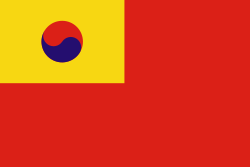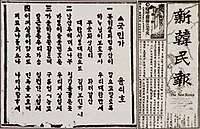Korean National Association
 | |
| Founded | 1 February 1909 |
|---|---|
| Founder | Ahn Changho |
| Type | Political Organization |
| Location | |
| Korean National Association | |
| Hangul | 국민회 |
|---|---|
| Hanja | 國民會 |
| Revised Romanization | Gungminhoe |
| McCune–Reischauer | Kungminhoe |
The Korean National Association (Hangul: 국민회; Hanja: 國民會) was a political organization established on February 1, 1909 to fight Japan’s colonial policies and occupation in Korea. It was founded in San Francisco by the intellectual scholar and Korean Independence activist, Ahn Changho, and represented the interests of Koreans in the United States, Siberia, and Manchuria during the Korean Independence Movement.[1]
Background
.svg.png)
After the Japan–Korea Treaty of 1905, multiple organizations emerged in Hawaii, California, and other parts of the US condemning Japan's colonial policies. However on March 23, 1908, after the pro-japanese diplomat, Durham White Stevens, was assassinated by two Korean immigrants, Korean-Americans in both Hawaii and the US mainland joined together to protect the rights of the two alleged assailants. This event and the growing need to consolidate patriotic efforts led to two major Korean civic organizations, the Mutual Assistance Society (MAS) in San Fransisco and United Korean Society in Hawaii, merging to form the KNA on February 1, 1909.[2]
Earlier Years
Following its establishment, the KNA was divided into multiple branches with a governing body called the Central Congress.[2] In late 1912, Ahn Changho and Park Yong-man were elected as the organization's first chairman and vice chairman.[1] As the leader of the central body, Ahn continued his work by organizing KNA regional branches and further strengthening and unifying the organization which through his efforts would expand across North America, Hawaii, Siberia and Manchuria. Though becoming more centralized, there remained conflicting interests within certain KNA regional branches such as Hawaii where Syngman Rhee, who looked for liberation through education and diplomacy, disagreed with Park Yong-man, who preferred military action. Ahn Changho went to Hawaii to mediate between the two leaders but with little success. [3]
On June 13 1914, a group of Korean Americans working at an apricot farm in Hemet, California was attacked by local citizens who didn’t want Asians working in that area. Initially, the Japanese consulate interceded with the government on behalf of the Korean Immigrants but that caused outrage within the Korean-American community. David Lee, the president of the North American branch of the KNA, sent a telegram to the US Secretary of state William Jessing Bryan, requesting that the Japanese government no longer represent Koreans. Despite the pressures from Japanese diplomats in Washington DC, Bryan ruled in the KNA’s favor. Ever since, matters regarding the Korean immigrants or students would be handled by the KNA organization instead. [4]
March 1st Movement
The March 1st Movement in 1919 rekindled the national spirit of Korean-Americans. When news of the demonstrations reached the US in mid-March, a mass rally was held by the KNA in San Francisco. The KNA first attempted to send a three-man delegation including Syngman Rhee to the Paris Peace conference but failed to receive necessary travel documentation. Afterwards, the KNA decided to establish a Korean Information Office headed by Philip Jaisohn then send him and Syngman Rhee to Philidelphia to lead the "the Korean Congress" held from April 14 to 16 of the same year to begin blueprinting the future Republic of Korea with 150 Koreans representing 27 organizations in the US and Mexico. [1] All organizations agreed upon a Korean republic based on democratic principles and pledged their support to the newly established Korean Provisional Government(KPG) in Shanghai. Ahn Changho, who was in Shanghai at that time, played an instrumental role in the government's establishment on April 13 and its early operations. This spike in activity within the organization lasted until the mid-1920s and would not regain its steam in the liberation movement until the Sino-Japanese War in 1937. [5] However, the KNA continued to launch independence funds which for the following decades collected money from Korean immigrants to financially support the provisional government and anti-Japanese activities.[2]

World War II
By the beginning of World War II, the KNA had expanded to more than 130 branches throughout the world[2] and was a key source of resistance and political empowerment, primarily through unifying the efforts of Korean immigrants and lobbying allied governments. After the bombing of Pearl Harbor in 1941, the KNA joined with other Korean organizations to form the United Korean Committee to continue providing financial and spiritual support for the KPG.[1] The selected chairman of the newly formed alliance was Syngman Rhee, who aimed to receive official recognition of the KPG as the government of Korea.
Since Liberation
After Korea’s liberation from Japan, the KNA continued to provide support for the Republic of Korea through relief efforts while promoting cultural, educational, and religious activities in Korean-American communities. The organization continued to serve the Korean-American community in the US until dissolving in 1988
Organizational Media

On February 10, 1910, the KNA published the weekly newspaper Sinhan Minbo (신한민보), or The New Korea . It published every Wednesday articles promoting the independence movement and advocating the interests of the Korean people. After World War II, it continued publishing weekly until being acquired by Kim Un Ha on September 1974 and published monthly instead. [6]
See Also
Citations
- 1 2 3 4 "The Korean Independence Movement in the United States" (PDF).
- 1 2 3 4 “Korean National Association” Asian American History and Culture: An Encyclopedia, p.488
- ↑ "The Korean Independence Movement in the United States" (PDF).
- ↑ Asian American: A Reader p.54
- ↑ Koreans in Central California (1903-1957): A Study of Settlement and Transnational Politics, p.93
- ↑ "Encyclopedia of Korean Culture (in Korean)".
References
- Kim, Han. K. (2002). The Korean Independence Movement in the United States. International Journal of Korean Studies, 6(1),1-27. Retrieved from http://icks.org/data/ijks/1482456493_add_file_1.pdf
- Ling, H, & Austin, A. H. “Korean National Association” Asian American History and Culture: An Encyclopedia. New York & Oxford, 2015, Routledge, 488. Print
- Wu, S., Yu-Wen, & J, Song, M. (2004) Asian-American Studies: A Reader. New Jersey, Rutgers, 54. Print
- Kyu, P. (1996) 신한민보(in Korean). In Encyclopedia of Korean Culture. Retrieved http://encykorea.aks.ac.kr/Contents/Index?contents_id=E0033529
- Cha, M.J. (2010) Koreans in Central California (1903-1957): A Study Of Settlement And Transnational Politics. Lanham, Maryland. University Press of America. Print